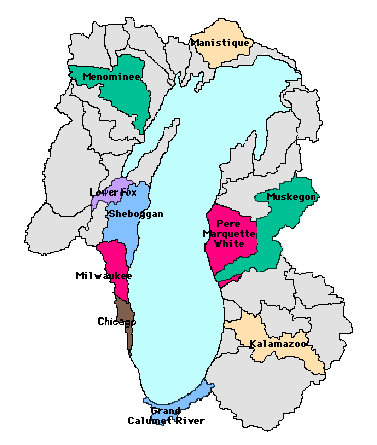LAKE MICHIGAN
Lake Michigan, the second largest Great Lake by volume with 1,180 cubic
miles of water, is the only Great Lake entirely within the United States. Approximately
118 miles wide and 307 miles long, Lake Michigan has more than 1,600 miles of shoreline.
Averaging 279 feet in depth, the lake reaches 925 feet at its deepest point. The lake's
northern tier is in the colder, less developed upper Great Lakes region, while its more
temperate southern basin contains the Milwaukee and Chicago metropolitan areas. The
drainage basin, approximately twice as large as the 22,300 square miles of surface water,
includes portions of Illinois, Indiana, Michigan and Wisconsin. Lake Michigan is
hydrologically inseparable from Lake Huron, joined by the wide Straits of Mackinac.
Lake Michigan receives most of its water from the Michigan side of its basin.
On its southwest flank, most of the surface water drains into the Illinois River and then
to the Gulf of Mexico, rather than into the lake. A small diversion of water at Chicago
also takes water out of the lake and diverts it into the Illinois River. Some of the
larger basins on the Michigan side are the Grand, Muskegon, Manistee, and Kalamazoo. The
Fox River valley, in Wisconsin, is notorious for being quite polluted; many paper mills
and heavy industry occur in the Fox Valley.

FACTS
Length - 307 miles / 494 km.
Breadth - 118 miles / 190 km.
Ave. Depth - 279 ft. / 85 m
Max. Depth - 925 ft. / 282 m.
Volume - 1,180 cubic miles / 4,920 cubic km.
Water Surface Area - 22,300 sq. miles / 57,800 sq. km.
Drainage Basin Area - 45,600 sq. miles / 118,000 sq. km.
Shoreline Length (including islands) - 1,638 miles / 2,633 km.
Elevation - 577 ft. / 176 m.
Outlet - Straits of Mackinac to Lake Huron
Retention/Replacement Time - 99 years
Name - Champlain called it the Grand Lac. It was later named "Lake of the Stinking
Water" or "Lake of the Puants," after the people who occupied its shores.
In 1679, the lake became known as Lac des Illinois because it gave access to the country
of the Indians, so named. Three years before, Allouez called it Lac St. Joseph, by which
name it was often designated by early writers. Others called it Lac Dauphin. Through the
further explorations of Jolliet and Marquette, the "Lake of the Stinking Water"
received its final name of Michigan.
Another story recounts that Nicolet, the first European to set foot in
Wisconsin in 1634, landed on the shores of Green Bay and was greeted by Winnebago Indians,
whom the French called "Puans." Lake Michigan was labeled as "Lake of
Puans" on an early and incomplete 1670 map of the region that showed only the
northern shores of the lake. However, only Green Bay is labeled as "Baye de
Puans" (Bay of the Winnebago Indians) on maps from 1688 and 1708. On the 1688 map,
Lake Michigan is called Lac des Illinois.
An Indian name for Lake Michigan was "Michi gami."
Lake Michigan is the third largest Great Lake by surface area and the sixth largest freshwater lake in the world.
Because Lake Michigan is joined to Lake Huron at the Straits of Mackinac, they are considered one lake hydrologically.
Many rivers and streams flow into Lake Michigan, and the major tributaries are the Fox-Wolf, the Grand and the Kalamazoo.
There is a diversion from the lake into the Mississippi River basin through the Illinois Waterway at the Chicago River.
Lake Michigan's cul-de-sac formation means that water entering the lake circulates slowly and remains for a long time (retention) before it leaves the basin through the Straits of Mackinac.
Small lunar tidal effects have been documented for Lake Michigan.
Internal waves (upwellings) can produce a 15 degree C. water temperature decrease along the coast in only a few hours, requiring drastic alterations in fishing strategy.
The northern part of the Lake Michigan watershed is covered with forests, sparsely populated, and economically dependent on natural resources and tourism, while the southern portion is heavily populated with intensive industrial development and rich agricultural areas along the shore.
The world's largest freshwater dunes line the lakeshore.
Millions of people annually visit the dunes/beaches at state and national parks and lakeshores.
This material has been compiled for educational use only, and
may not be reproduced without permission. One copy may be printed for personal
use. Please contact Randall Schaetzl (soils@msu.edu)
for more information or permissions.